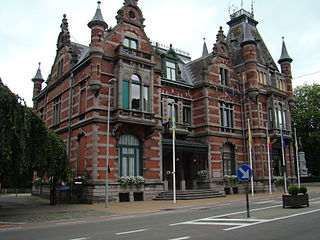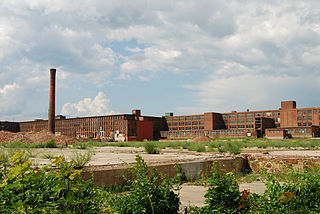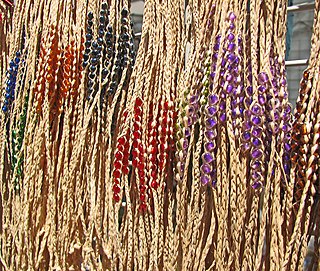
The Jacquard machine is a device fitted to a loom that simplifies the process of manufacturing textiles with such complex patterns as brocade, damask and matelassé. The resulting ensemble of the loom and Jacquard machine is then called a Jacquard loom. The machine was patented by Joseph Marie Jacquard in 1804, based on earlier inventions by the Frenchmen Basile Bouchon (1725), Jean Baptiste Falcon (1728), and Jacques Vaucanson (1740). The machine was controlled by a "chain of cards"; a number of punched cards laced together into a continuous sequence. Multiple rows of holes were punched on each card, with one complete card corresponding to one row of the design.

Linen is a textile made from the fibers of the flax plant.

West Flanders is the westernmost province of the Flemish Region, in Belgium. It is the only coastal Belgian province, facing the North Sea to the northwest. It has land borders with the Dutch province of Zeeland to the northeast, the Flemish province of East Flanders to the east, the Walloon province of Hainaut in the south and the French department of Nord to the west. Its capital is Bruges (Brugge). Other important cities are Kortrijk in the south and Ostend (Oostende) on the coast, Roeselare and Ypres (Ieper). The province has an area of 3,197 km2 (1,234 sq mi) which is divided into eight administrative districts (arrondissementen) containing 64 municipalities. As of January 2024, West Flanders has a population of over 1.22 million.

Wevelgem is a municipality located in the Belgian province of West Flanders. The municipality comprises the towns of Gullegem, Moorsele and Wevelgem proper. On January 1, 2006, Wevelgem had a total population of 31,020. The total area is 38.76 km2 which gives a population density of 800 inhabitants per km2.

In the manufacture of cloth, warp and weft are the two basic components in weaving to transform thread and yarn into textile fabrics. The vertical warp yarns are held stationary in tension on a loom (frame) while the horizontal weft is drawn through the warp thread. In the terminology of weaving, each warp thread is called a warp end ; a pick is a single weft thread that crosses the warp thread.

Damask is a woven, reversible patterned fabric. Damasks are woven by periodically reversing the action of the warp and weft threads. The pattern is most commonly created with a warp-faced satin weave and the ground with a weft-faced or sateen weave. Yarns used to create damasks include silk, wool, linen, cotton, and synthetic fibers, but damask is best shown in cotton and linen. Over time, damask has become a broader term for woven fabrics with a reversible pattern, not just silks.

Irish linen is the name given to linen produced in Ireland. Linen is cloth woven from, or yarn spun from, flax fibre, which was grown in Ireland for many years before advanced agricultural methods and more suitable climate led to the concentration of quality flax cultivation in northern Europe.
The manufacture of textiles is one of the oldest of human technologies. To make textiles, the first requirement is a source of fiber from which a yarn can be made, primarily by spinning. The yarn is processed by knitting or weaving, with color and patterns, which turns it into cloth. The machine used for weaving is the loom. For decoration, the process of coloring yarn or the finished material is dyeing. For more information of the various steps, see textile manufacturing.

The Draper Corporation was once the largest maker of power looms for the textile industry in the United States. It operated in Hopedale, Massachusetts for more than 130 years.
Textile manufacturing is one of the oldest human activities. The oldest known textiles date back to about 5000 B.C. In order to make textiles, the first requirement is a source of fibre from which a yarn can be made, primarily by spinning. The yarn is processed by knitting or weaving to create cloth. The machine used for weaving is the loom. Cloth is finished by what are described as wet process to become fabric. The fabric may be dyed, printed or decorated by embroidering with coloured yarns.

Hemp jewelry uses hemp twine material which is made from the Cannabis sativa plant, otherwise known as “Common Hemp”, which is cultivated to make goods such as food, fuel, clothing and textiles, cosmetics, paints, paper, building materials, and plastics, among others. Some types of hemp jewelry include bracelets, necklaces, anklets, rings, watches, masks, purses, and other adornments. The jewelry can also make use of other materials, such as glass, wood, bones, rocks, or gems.

A reed is part of a weaving loom, and resembles a comb or a frame with many vertical slits. It is used to separate and space the warp threads, to guide the shuttle's motion across the loom, and to push the weft threads into place. In most floor looms with, the reed is securely held by the beater. Floor looms and mechanized looms both use a beater with a reed, whereas Inkle weaving and tablet weaving do not use reeds.

Geo. Hattersley was a textile machinery manufacturer from Keighley, West Yorkshire in England, founded in 1789 and responsible for the Hattersley Standard Loom and other types of looms.
Weaving and cloth trading communities of Western India particularly of Gujarat are called Vankar/Wankar/Vaniya. The four major woven fabrics produced by these communities are cotton, silk, khadi and linen. Today majority of these community members are not engaged in their ancestral weaving occupation still some population of these community contribute themselves in traditional handloom weaving of famous Patola of Patan, Kachchh shawl of Bhujodi in Kutch, Gharchola and Crotchet of Jamnagar, Zari of Surat, Mashroo of Patan and Mandvi in Kutch, Bandhani of Jamnagar, Anjar and Bhuj, Motif, Leheria, Dhamakda and Ajrak, Nagri sari, Tangaliya Shawl, Dhurrie, Kediyu, Heer Bharat, Abhala, Phento and art of Gudri. Vankar is described as a caste as well as a community.

Donegal tweed is a woven tweed manufactured in County Donegal, Ireland. Originally all handwoven, it is now mostly machine woven and has been since the introduction of mechanised looms in the 1950s-1960s. Donegal has for centuries been producing tweed from local materials in the making of caps, suits and vests. Towards the end of the eighteenth century, The Royal Linen Manufacturers of Ulster distributed approximately six thousand flax spinning wheels and sixty looms for weaving to various Donegal homesteads. These machines helped establish the homespun tweed industry in nineteenth-century Donegal. Although Donegal tweed has been manufactured for centuries it took on its modern form in the 1880s, largely due to the pioneering work of English philanthropist Alice Rowland Hart.
Brahms Mount is a textiles manufacturer, established in 1983 in Hallowell, Maine. It designs and creates a variety of soft furnishings in natural fibers, including blankets and throws, using traditional weaving techniques and antique equipment.

The Bocholt textile museum is a museum in Bocholt, a city in the north-west of North Rhine-Westphalia, Germany, part of the district Borken. It is situated 4 km south of the border with the Netherlands. The museum opened in 1989 as one of the eight locations of the LWL Industrial Museum: it is an Anchor point on the European Route of Industrial Heritage.

The Game of Thrones Tapestry is a hand-crafted tapestry, woven by hand on a jacquard loom, with additional embroidery. The tapestry tells the entire story of the television show, Game of Thrones. It consists of seven 11-metre-long panels and one 10.5-metre panel. The eight panels depict scenes from each episode and include images of crew at work. The tapestry was commissioned by HBO and Tourism Ireland, the tourism bureau of Northern Ireland where HBO filmed much of the series.

Belgian Linen is a registered trademark of the Belgian Flax and Linen Association, a trade association that represents over 1,500 artisans and companies that grow and transform flax in Belgium. Since 1960, the association oversees and coordinates the Belgian Linen trademark. There are strict limitations on the use of the label: it has to match a set of quality standards and a certificate can be obtained only by Belgian companies. These standards include that at least 85% of the product by weight contains natural vegetable flax fibres of European Union-origin.
Safilin is a French company specializing in linen and hemp spinning. Founded in 1778 in Armentières (Hauts-de-France), the company did not take its current name of Safilin until 1986. Headquartered in Sailly-sur-la-Lys, the company has relocated its production in Poland.















